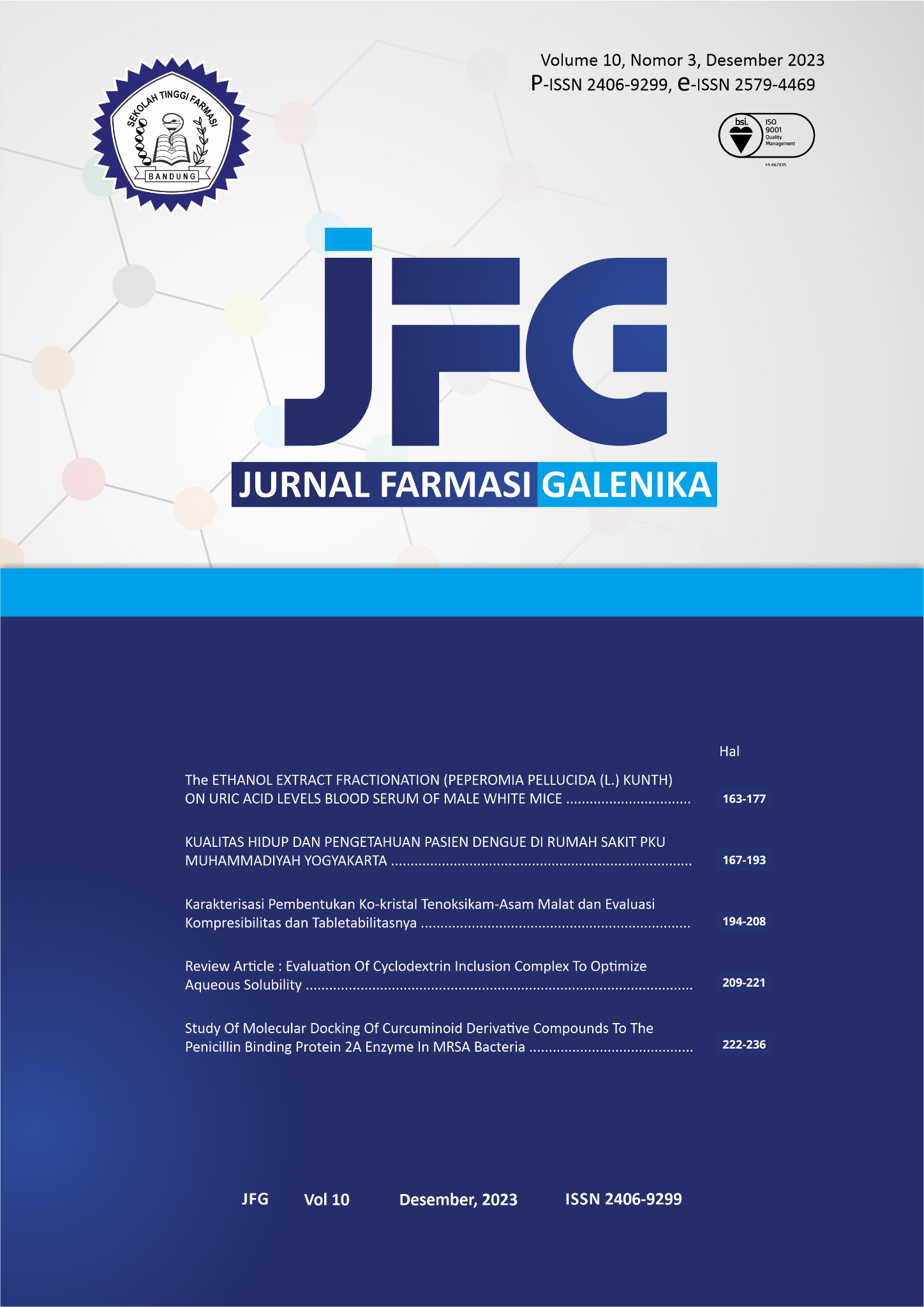Kualitas Hidup Dan Pengetahuan Pasien Dengue Di Rumah Sakit Pku Muhammadiyah Yogyakarta
DOI:
https://doi.org/10.70410/jfg.v10i3.309Keywords:
Dengue, kualitas hidup, tingkat pengetahuanAbstract
Angka kejadian kasus infeksi dengue tahun 2020 di Kota Yogyakarta sebanyak 296 orang. Berdasarkan manifestasi klinis dengue terbagi menjadi 3 diagnosa yaitu dengue fever (DF), dengue haemorrhagic fever (DHF) dan dengue shock syndrome (DSS). Penularan terjadi akibat gigitan nyamuk Aedes aegypti dan mobilitas yang tinggi. Beberapa faktor yang mempengaruhi angka kejadian yaitu kualitas hidup dan pengetahuan terhadapa penyakit yang berdampak pada tingkat kesehatan. Tujuan penelitian untuk mengetahui kualitas hidup dan pengetahuan. Penelitian ini dilakukan secara observasional dengan pengambilan data prosfektif di Rumah Sakit PKU Muhammadiyah Yogyakarta periode April – Desember 2021. Kualitas hidup pasien dinilai menggunakan kuisioner EQ-5D-Y untuk pasien anak dan EQ-5D-5L untuk pasien dewasa dan pengetahuan dinilai menggunakan kuisioner yang terdiri dari pengetahuan penyakit, pengetahuan pencegahan dan prilaku pencegahan. Hasil penelitian di RS PKU Muhammadiyah Yogyakarta pada pasien dengan diagnosa DHF sebanyak 40% merasa amat sangat bermasalah pada kegiataan yang biasa dilakukan dan sebanyak 40% merasa cukup bermasalah pada dimensi rasa cemas, sedih dan depresi sehingga berpengaruh pada kulitas hidup. Pada pengetahuan penyakit, pengetahuan pencegahan dan perilaku pencegahan pasien DF dan DHF tergolong dalam kategori buruk sehingga perlu adanya promosi kesehatan untuk meningkatkan pengetahuan terhadap kesehatan. Penyakit demam dengue berpengaruh pada kulitas hidup. pengetahuan terhadap penyakit demam dengue dalam kategori buruk.
Downloads
References
Baitipur, R. (2018) “Pendidikan Kesehatan Melalui Video Untuk Meningkatkan Pengetahuan Dan Praktik Psn Dbd,” JHE (Journal of Health Education), 3(2), hal. 86–90. doi: 10.15294/jhe.v3i2.17444.
Bhatt, S. et al. (2013) “The global distribution and burden of dengue,” Nature, 496(7446), hal. 504–507. doi: 10.1038/nature12060.
Candra, A. (2010) “Dengue Hemorrhagic Fever?: Epidemiology , Pathogenesis , and Its Transmission Risk Factors,” Apirator, 2(2), hal. 110–119.
DinKes (2020) Profil Kesehatan Kota Yogyakarta Tahun 2020 (Data Tahun 2019). DIY, Kota Yogyakarta.
DinKes (2021) “Profil kesehata Provinsi DIY Tahun 2020,” hal. 36.
Emrani, Z. et al. (2020) “Health-related quality of life measured using the EQ-5D-5 L: Population norms for the capital of Iran,” Health and Quality of Life Outcomes, 18(1), hal. 1–9. doi: 10.1186/s12955-020-01365-5.
Giena, V. P., Riyani, O. dan Effendi (2020) “Pengaruh penyuluhan kesehatan terhadap tingkat pengetahuan masyarakat tentang demam berdarah dengue di wilayah kerja Puskesmas Basuki Rahmad Kota Bengkulu,” Al-Asalmiya Nursing, 9, hal. 69–79. Tersedia pada: https://jurnal.stikes-alinsyirah.ac.id/index.php/keperawatan/.
Itrat, A. et al. (2008) “Knowledge, awareness and practices regarding dengue fever among the adult population of dengue hit cosmopolitan,” PLoS ONE, 3(7), hal. 1–6. doi: 10.1371/journal.pone.0002620.
Kemenkes RI (2017) “Pedoman Pencegahan dan Pengendalian Demam Berdarah Dengue Indonesia,” Pedoman pencegahan dan pengendalian demam berdarah di indonesia, 5(7), hal. 9.
Khan, E. et al. (2010) “Demographic and clinical features of dengue fever in Pakistan from 2003-2007: A retrospective cross- sectional study,” PLoS ONE, 5(9), hal. 1–7. doi: 10.1371/journal.pone.0012505.
Lum, L. C. S. et al. (2008) “Quality of Life of Dengue Patients,” American Journal of Tropical Medicine and Hygiene, 78(6), hal. 862–867. doi: 10.4269/ajtmh.2008.78.862.
Mei Lestari, H. K. (2021) “Pengaruh Pendidikan Kesehatan Masyarakat Terhadap Pengetahuan Tentang Penanganan Demam Berdarah Dengue,” Indonesian Health Science Journal, 1(1), hal. 1–6.
Nguyen, L. H. et al. (2017) “Quality of life profile of general Vietnamese population using EQ-5D-5L,” Health and Quality of Life Outcomes, 15(1), hal. 1–13. doi: 10.1186/s12955-017-0771-0.
Notoatmodjo (2014) Promosi Kesehatan dan Ilmu Perilaku. Diedit oleh Rineka Cipta. Jakarta.
Novrita, B., Mutahar, R. dan Purnamasari, I. (2017) “The Analysis of Incidence Of Dengue Hemorrhagic Fever in Public Health Center of Celikah Ogan Komering Ilir Regency,” Jurnal Ilmu Kesehatan Masyarakat, 8, hal. 20–28.
Permatasari, D. Y., Ramaningrum, G. dan Novitasari, A. (2015) “Hubungan status Gizi, umur, dan jenis kelamin dengan derajat infeksi dengue Pada anak,” Jurnal Kedokteran Muhammadiyah, 2(1), hal. 24–28.
Purba, F. D. et al. (2017) “The Indonesian EQ-5D-5L Value Set,” PharmacoEconomics, 35(11), hal. 1153–1165. doi: 10.1007/s40273-017-0538-9.
Rachman, Z. F. (2021) “Hubungan Status Gizi dengan Kejadian DHF pada Anak di Tk RA-AL Kamal 4 Bukuan Kota Samarinda,” 2(3), hal. 1815–1820.
Reenen, M. van et al. (2019) “EQ-5D User Guide,” EueoQol Research Foundation, hal. 36. Tersedia pada: https://euroqol.org/publications/user-guides/.
Stanaway, J. D. et al. (2016) “The Global Burden of Dengue: an analysis from the Global Burden of Disease Study 2013,” Lancet Infect Dis, 16(6), hal. 712–723. doi: 10.1016/S1473-3099(16)00026-8.The.
Suaya, J. A. et al. (2009) “Cost of dengue cases in eight countries in the Americas and asia: A prospective study,” American Journal of Tropical Medicine and Hygiene, 80(5), hal. 846–855. doi: 10.4269/ajtmh.2009.80.846.
Sumampouw, O. J. (2020) “Epidemiologi Demam Berdarah Dengue di Kabupaten Minahasa Sulawesi Utara,” Sam Ratulangi Journal of Public Health, 1(1), hal. 001. doi: 10.35801/srjoph.v1i1.27272.
Trapsilowati, Pujiyanti, R. (2014) “Role Of Knowledge and Education Level to Dengue Vector Control Behavior in Endemic Villages Community in Samarinda 2009,” 6(September), hal. 41–45.
WHO (2011) Comprehensive guidelines for prevention and control of dengue and dengue haemorrhagic fever, WHO Regional Publication SEARO. Tersedia pada: http://scholar.google.com/scholar?hl=en&btnG=Search&q=intitle:Comprehensive+Guidelines+for+Prevention+and+Control+of+Dengue+and+Dengue+Haemorrhagic+Fever#1.
Downloads
Published
How to Cite
Issue
Section
Citation Check
License
Authors who publish in Jurnal Farmasi Galenika agree to the following terms:
This license enables reusers to distribute, remix, adapt, and build upon the material in any medium or format, so long as attribution is given to the creator. The license allows for commercial use. CC BY includes the following elements:
BY: credit must be given to the creator.
You are free to:
- Share — copy and redistribute the material in any medium or format for any purpose, even commercially.
- Adapt — remix, transform, and build upon the material for any purpose, even commercially.
- The licensor cannot revoke these freedoms as long as you follow the license terms.
Under the following terms:
- Attribution — You must give appropriate credit , provide a link to the license, and indicate if changes were made . You may do so in any reasonable manner, but not in any way that suggests the licensor endorses you or your use.
- No additional restrictions — You may not apply legal terms or technological measures that legally restrict others from doing anything the license permits.
Notices:
You do not have to comply with the license for elements of the material in the public domain or where your use is permitted by an applicable exception or limitation .
No warranties are given. The license may not give you all of the permissions necessary for your intended use. For example, other rights such as publicity, privacy, or moral rights may limit how you use the material.










